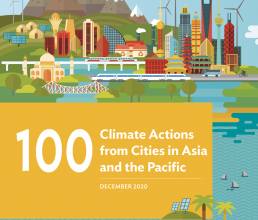First appeared in

Asian Development Bank
100 Climate Actions from Cities in Asia and the Pacific
Viet Nam begins its energy transition with a 50 megawatt (MW) solar plant just outside the capital city.
Viet Nam begins its energy transition with a 50 megawatt (MW) solar plant just outside the capital city.
Fifty kilometers outside Ho Chi Minh, Viet Nam’s most populous city, is one of the country’s first utility-scale solar power plants. The plant began operations in mid-2019 and generates roughly 78,000 MWh of clean energy annually. This will meet the needs of an estimated 40,000 Vietnamese households and reduce annual carbon dioxide emissions by around 29,760 tons by 2020.
29.8K
TONS CO₂ SAVED ANNUALLY
Viet Nam seeks to increase the share of renewable energy, including small hydro, solar, wind, and biomass power plants, as a percentage of total forecast installed capacity to 21% by 2030 and to reduce the use of imported coal-fired electricity. To meet this target, installed solar power capacity is expected to increase to 12 GW and wind power to 6 GW by 2030. Rapidly scaling up renewable energy use will also help Viet Nam achieve its target to reduce greenhouse gas emissions by 8% – 25% by 2030.
The $51.5 million project was funded through an ADB loan as well as co-financing from commercial banks, a non-parallel loan from Leading Asia’s Private Infrastructure Fund, and sponsors’ equity.

The plant is located about 50 km outside of Ho Chi Minh (photo by TTC Energy Development Investment Joint Stock Company).
The Challenge
Expanding Viet Nam’s power supply will require significant private sector investment. With limited potential to further develop hydropower and growing public environmental concerns from coal, the development of renewable energy is crucial.
Co-Benefits
Economic Electricity supplied to Viet Nam’s power grid will increase the availability and reliability of clean power, thereby increasing industrial and agricultural productivity.
Social Adding new, reliable capacity to the power grid will increase access to power in remote areas, promoting socioeconomic development and increasing access to improved infrastructure and services.

